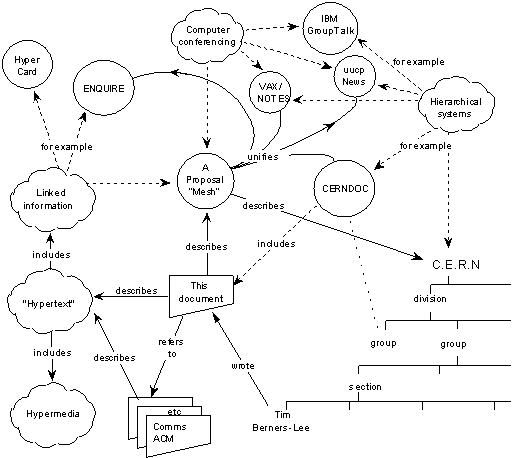OP KET => SUPERPOSITION
Certainly powerful enough to map a flow chart to a relatively readable BKO.
Consider the flow chart from the original html proposal:
In BKO is simply:
|context> => |context: www proposal> describes |document: www proposal> => |"Hypertext"> + |A Proposal "Mesh"> refers-to |document: www proposal> => |Comms ACM> describes |Comms ACM> => |"Hypertext"> includes |"Hypertext"> => |Linked information> + |Hypermedia> for-example |Linked information> => |Hyper Card> + |ENQUIRE> + |A Proposal "Mesh"> describes |a proposal "mesh"> => |CERN> unifies |a proposal "mesh"> => |ENQUIRE> + |VAX/NOTES> + |uucp News> + |CERNDOC> examples |Computer conferencing> => |IBM GroupTalk> + |uucp News> + |VAX/NOTES> + |A Proposal "Mesh"> for-example |Hierarchical systems> => |CERN> + |CERNDOC> + |Vax/Notes> + |uucp News> + |IBM GroupTalk> includes |CERNDOC> => |document: www proposal> wrote |person: Tim Berners-Lee> => |document: www proposal>
So, if we study the flow-chart vs the BKO we observe that nodes in the chart map to kets, and arrows map to operators. eg, |document: www proposal> and "describes" respectively.
Indeed, if text was not 1D, we could actually put the operators above the => symbol, to make the mapping even clearer.
I guess the final thing to note is that all the coeffs are 1, since in this flow-chart the arrows do not specify weights.
And that's it for now!

No comments:
Post a Comment